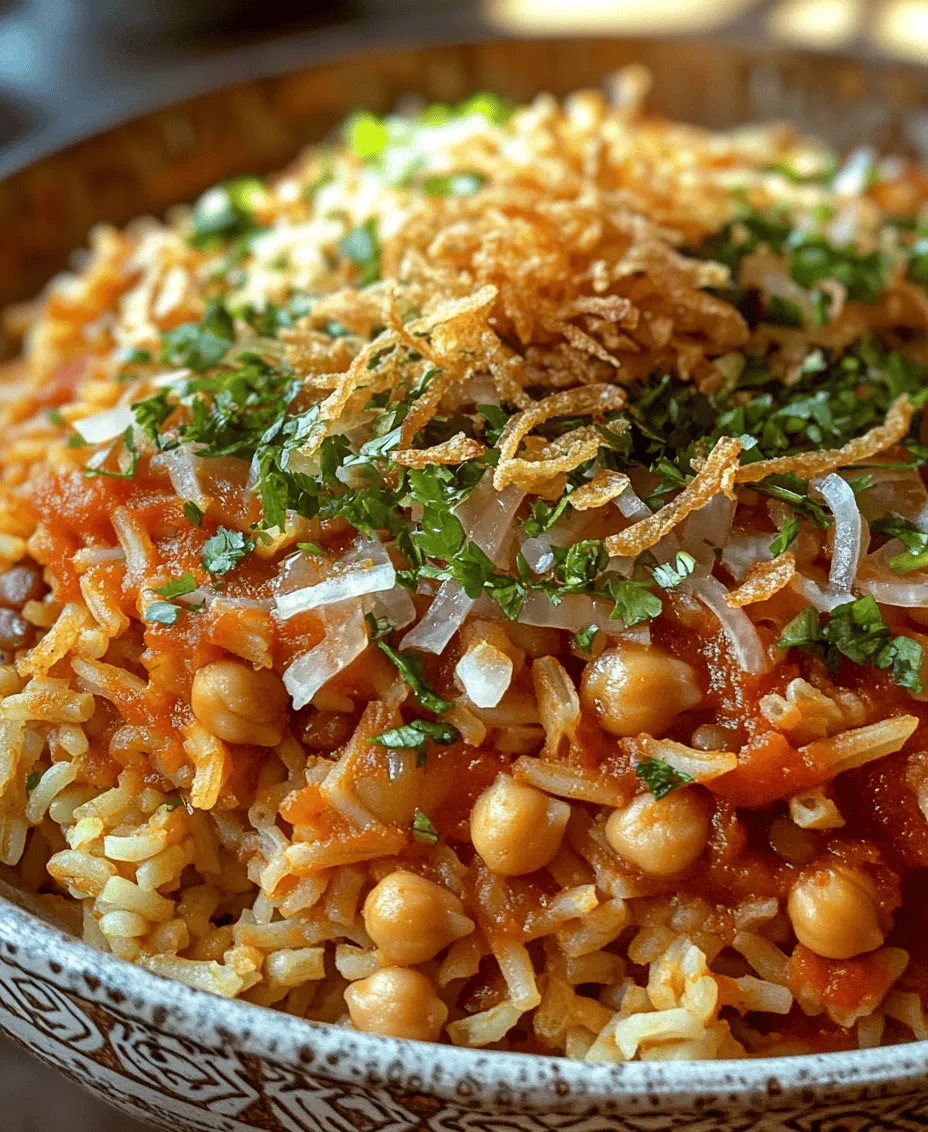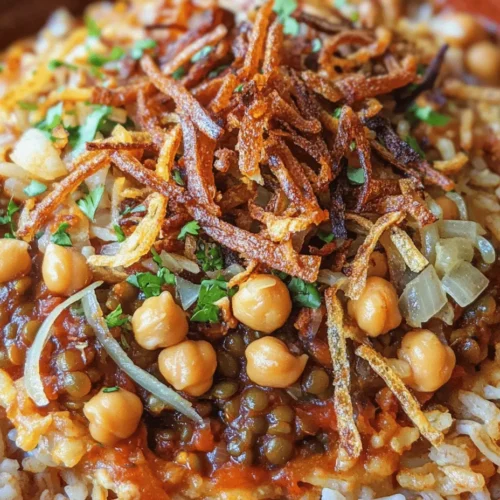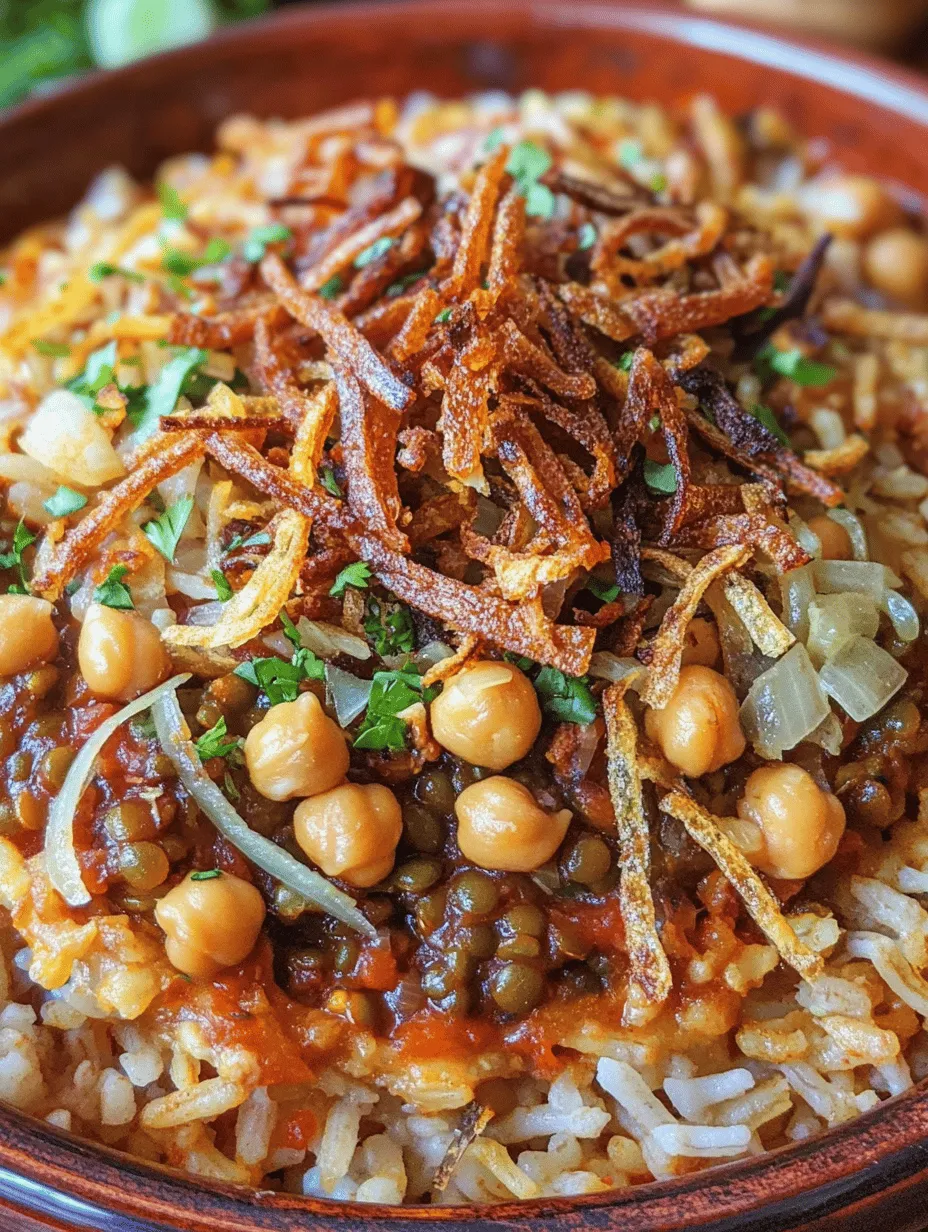Introduction
Koshari, a quintessential Egyptian dish, is more than just a meal; it’s a culinary celebration that has found its way into the hearts and homes of Egyptians and food lovers around the world. Known for its vibrant combination of flavors, textures, and colors, Koshari is a dish that tells a story of Egypt’s rich cultural tapestry. From bustling street vendors to family gatherings, Koshari has become a symbol of comfort food that unites families and friends over shared meals.
Tracing its origins back to the late 19th century, Koshari is a fusion of influences—Arabic, Italian, and even Indian—that reflect the historical exchanges that have shaped Egypt. Traditionally served in large portions, Koshari is a hearty meal made with simple, wholesome ingredients that provide a sense of satisfaction with every bite. As you delve into the world of Koshari, you’ll discover not only a delicious recipe but also a dish that embodies the spirit of Egyptian hospitality.
In this article, we will explore the key components that make up Koshari, from the protein-rich lentils to the aromatic sauce that pulls everything together. We’ll then guide you through the step-by-step process of preparing this beloved dish, ensuring that you can recreate this Egyptian delight in your own kitchen.
Exploring the Ingredients of Koshari
At the heart of Koshari lies a medley of ingredients, each contributing its unique flavor and nutritional benefits. Understanding these components will not only enhance your appreciation for this dish but also empower you to make it authentically. Let’s dive into the essential ingredients that create the delicious tapestry of Koshari.
Lentils: The Protein Powerhouse
Lentils are the backbone of Koshari, providing both protein and fiber that make this dish filling and nutritious. Known for their versatility, lentils come in various types, but the brown and green varieties are commonly used in Koshari. Packed with essential vitamins and minerals, such as iron, folate, and magnesium, lentils are a staple in vegetarian diets, making them an ideal choice for this dish.
In addition to their nutritional benefits, lentils offer a subtle earthiness that complements the other ingredients in Koshari. They are also relatively quick to cook, making them a practical choice for busy cooks. When properly seasoned, lentils become a flavorful addition that enhances the overall depth of Koshari.
Rice: The Foundation of Koshari
Rice serves as the foundation of Koshari, providing a soft and fluffy base that absorbs the flavors of the dish. Long-grain rice is preferred for its ability to remain separate and fluffy, ensuring that each grain is coated in the rich sauce that accompanies the dish. The starchiness of the rice works harmoniously with the lentils and macaroni, creating a satisfying texture that enhances the eating experience.
Choosing the right type of rice is crucial, as it can significantly affect the final outcome of the Koshari. Basmati or Egyptian rice varieties are excellent choices, as they have a delicate flavor and aroma that complements the other ingredients. Cooking the rice to perfection—fluffy and not mushy—is essential for achieving that authentic Koshari experience.
Macaroni: The Comfort Element
Adding a twist to traditional grain-based dishes, Koshari features macaroni as a unique element that contributes to its comfort-food quality. The use of short pasta, typically elbow macaroni, introduces a delightful chewiness that contrasts beautifully with the softer ingredients. This incorporation of pasta is reminiscent of other comfort foods around the world, where noodles or pasta are combined with hearty components to create a filling dish.
The macaroni not only adds texture but also serves as a vehicle for the sauce, ensuring that each bite is bursting with flavor. As the macaroni cooks, it absorbs the spices and aromatic notes from the sauce, further enriching the overall taste of Koshari.
Chickpeas: A Nutritious Topper
Chickpeas play a pivotal role in Koshari, serving as a nutritious topper that adds both texture and additional protein. These legumes are not only a great source of plant-based protein but also provide a creamy, nutty flavor that balances the dish. Rich in fiber, chickpeas contribute to the overall healthiness of Koshari while promoting a feeling of fullness.
When prepared correctly, chickpeas can be served warm and slightly crispy, creating a delightful contrast to the other softer elements of the dish. They are often seasoned simply with salt and pepper, allowing their natural flavor to shine through. The inclusion of chickpeas is a nod to the importance of legumes in Egyptian cuisine, where they are celebrated for their versatility and nutritional value.
The Aromatic Sauce: A Burst of Flavor
No Koshari is complete without its signature sauce, a vibrant blend of tomatoes, garlic, and spices that ties the dish together. This sauce is a key element that elevates Koshari from a simple combination of ingredients to a culinary masterpiece. The base is typically made with crushed tomatoes, which provide a rich, tangy flavor that complements the earthiness of the lentils and the starchiness of the rice and macaroni.
Garlic and onion are essential aromatics that enhance the sauce’s depth, while spices such as cumin, coriander, and chili powder add warmth and complexity. The choice of spices can vary based on personal preference, but they are crucial in giving Koshari its distinctive flavor profile. As the sauce simmers and thickens, the flavors meld together, creating a luscious coating that envelops each ingredient in deliciousness.
The Cooking Process: Step-by-Step Guide to Making Koshari
Now that we’ve explored the ingredients that come together to create Koshari, it’s time to embark on the cooking journey. Making Koshari can seem daunting due to the variety of components, but with a clear step-by-step approach, you’ll find that it is both manageable and rewarding. Below is a comprehensive guide to preparing this flavorful dish.
Step 1: Gather Your Ingredients
Before you begin cooking, ensure you have all the necessary ingredients on hand. Here’s a list for reference:
– For the Koshari:
– 1 cup of lentils (preferably brown or green)
– 1 cup of long-grain rice
– 1 cup of elbow macaroni
– 1 can (15 oz) of chickpeas, drained and rinsed
– Salt and pepper to taste
– For the Sauce:
– 2 tablespoons of vegetable oil
– 1 medium onion, finely chopped
– 4 cloves of garlic, minced
– 1 can (14 oz) of crushed tomatoes
– 1 teaspoon of cumin
– 1 teaspoon of coriander
– 1 teaspoon of chili powder (adjust based on spice preference)
– Salt to taste
– Fresh lemon juice (optional, for serving)
Step 2: Cook the Lentils
Start by rinsing the lentils under cold water to remove any debris. Place them in a pot with three cups of water and a pinch of salt. Bring the water to a boil, then reduce the heat and let the lentils simmer for about 15-20 minutes, or until they are tender but not mushy. Drain any excess water and set the lentils aside.
Step 3: Prepare the Rice
In a separate pot, rinse the rice under cold water until the water runs clear. This step helps remove excess starch, resulting in fluffier rice. Add two cups of water and a pinch of salt to the pot and bring it to a boil. Once boiling, reduce the heat to low, cover the pot, and cook for 15-20 minutes, or until the rice is tender and all the water has been absorbed. Fluff the rice with a fork and set it aside.
Step 4: Cook the Macaroni
Bring a pot of salted water to a boil and add the elbow macaroni. Cook according to the package instructions until al dente. Drain the macaroni and rinse it with cold water to stop the cooking process. Set aside.
Step 5: Make the Sauce
In a large skillet, heat the vegetable oil over medium heat. Add the chopped onion and sauté until it becomes translucent, about 5 minutes. Next, add the minced garlic and cook for an additional minute until fragrant. Stir in the crushed tomatoes, cumin, coriander, chili powder, and salt. Bring the mixture to a simmer and let it cook for about 10-15 minutes, allowing the flavors to meld and the sauce to thicken.
Step 6: Combine the Ingredients
Once all components are cooked, it’s time to assemble the Koshari. In a large serving dish or individual bowls, layer the ingredients starting with rice at the bottom, followed by lentils, macaroni, and then topped with chickpeas. Generously drizzle the aromatic sauce over the top, ensuring that every layer is coated in flavor.
This method not only enhances the presentation but also allows each component to shine. The warm sauce will soak into the rice and lentils, creating a deliciously cohesive dish that embodies the essence of Koshari.
As you savor each bite of Koshari, you’ll experience the harmonious blend of textures and flavors that make this dish a true culinary gem from Egypt. Enjoy the process of cooking and sharing this delightful meal with friends and family, creating memories that will last a lifetime. Stay tuned for the next part of this article, where we will explore additional tips for perfecting your Koshari and answer some common questions about this beloved dish.

Preparing the Lentils
To create the perfect Koshari, the first step is preparing the lentils. Rinse the lentils under cold running water to remove any dust or impurities. This step is crucial as it ensures that your lentils are clean and will cook evenly. After rinsing, place the lentils in a pot and add enough water to cover them by about two inches. Bring the water to a boil, then reduce the heat to a simmer.
Cooking time can vary depending on the type of lentils used. Red lentils typically cook in about 15-20 minutes, while green or brown lentils may take 25-30 minutes. The goal is to achieve a tender texture without turning mushy. To check for doneness, taste a few lentils; they should be soft but still hold their shape. Once cooked, drain any excess water and set the lentils aside. For an added flavor boost, consider simmering them with a bay leaf or a piece of onion during cooking.
Cooking the Rice
Next, it’s time to cook the rice, which forms a significant layer in the Koshari. Begin by measuring out the rice you will need. A good rule of thumb is one cup of rice for every two cups of water. Rinse the rice thoroughly under cold water until the water runs clear. This removes excess starch, which can make the rice sticky and clump together during cooking.
Once rinsed, soak the rice in water for about 20-30 minutes to help it cook evenly. In a pot, bring water to a boil and add a pinch of salt. Afterward, add the soaked rice, reducing the heat to low, and cover the pot. Cook the rice for about 15-20 minutes or until all the water is absorbed and the rice is fluffy. Avoid lifting the lid too often, as this can release steam necessary for cooking. Once done, remove it from heat and let it sit for another 5-10 minutes, then fluff with a fork to separate the grains.
Cooking the Macaroni
The next ingredient in Koshari is macaroni. For the best results, use small pasta shapes, such as elbow macaroni. Begin by bringing a large pot of salted water to a rapid boil. The salt is essential; it not only flavors the pasta but also helps in achieving the right cooking texture. Add the macaroni and cook according to the package instructions, usually around 7-9 minutes, or until al dente. It’s crucial to avoid overcooking the pasta, as it will continue to cook slightly after being drained.
Once the macaroni is cooked, drain it and rinse it briefly under cold water to stop the cooking process. This step also helps to prevent the pasta from sticking together. Set the macaroni aside until you are ready to assemble the Koshari.
Making the Sauce
The sauce is what ties Koshari together and gives it its signature flavor. Start by heating a generous amount of oil in a pan over medium heat. Add finely chopped onions and sauté them until they turn golden brown. This caramelization process is vital as it brings out the natural sweetness of the onions, adding depth to the sauce.
Next, add minced garlic and cook for another minute, being careful not to let it burn. Once the garlic is fragrant, stir in diced tomatoes, along with spices such as cumin, coriander, and a pinch of cayenne for heat. Season with salt and pepper to taste. Allow the sauce to simmer for about 15-20 minutes, stirring occasionally, until it thickens. You can also add a splash of vegetable broth or water if the sauce becomes too thick. This rich tomato sauce, infused with aromatic spices, is essential for elevating the Koshari experience.
Assembling the Koshari
Assembling Koshari is where the magic happens. Start by layering the ingredients in a large serving dish or individual bowls. Begin with a base of rice, pressing it down lightly to create an even layer. Next, add a generous layer of lentils over the rice, followed by a layer of macaroni.
Drizzle some of the tomato sauce over the top of the pasta. Continue layering with the remaining ingredients, finishing with a final topping of sauce. For an authentic presentation, garnish with fried onions, which add a delightful crunch and flavor contrast. You can also sprinkle fresh herbs like parsley or cilantro for a pop of color and freshness.
Serving Suggestions and Variations
Koshari is delicious on its own, but it can be elevated with various accompaniments. A traditional addition is a spicy chili sauce, known as “shatta,” which can be drizzled over the top for those who love a bit of heat. A splash of vinegar can also enhance the dish, providing a tangy contrast to the richness of the sauce and the starchiness of the grains.
You can also explore variations of Koshari by adding different vegetables such as sautéed bell peppers, carrots, or even roasted eggplant. For those looking for added protein, consider incorporating chickpeas or lentils directly into the layers. Some might even choose to serve Koshari with grilled chicken or beef on the side for a heartier meal.
Cultural Significance of Koshari in Egyptian Cuisine
Koshari holds a special place in Egyptian culture, often regarded as the national dish. It has a rich history, having originated during the 19th century in Egypt, where it started as a street food staple. Vendors would serve this hearty meal in bustling markets, making it accessible to all social classes. Its affordability and satisfying nature made it a beloved choice for families and individuals alike.
In homes, Koshari is often accompanied by gatherings and celebrations. It is a comforting dish that brings people together, symbolizing hospitality and generosity. It is commonly served during Ramadan and other festive occasions, highlighting its significance in Egyptian culinary traditions.
Nutritional Benefits of Koshari
Koshari is not only a flavorful dish but also a balanced meal. It combines carbohydrates from rice, lentils, and macaroni with proteins, making it a wholesome option for various diets. Lentils are a fantastic source of plant-based protein and fiber, promoting digestive health and providing sustained energy. The inclusion of rice and pasta offers essential carbohydrates, while the tomato sauce adds vitamins and antioxidants.
This dish is suitable for vegetarians and vegans, providing a complete protein profile when combined. It can also be modified to cater to gluten-free diets by substituting gluten-containing pasta with gluten-free varieties. Overall, Koshari is a nutrient-dense meal that satisfies both the palate and nutritional needs.
Conclusion
Koshari is more than just a meal; it represents a rich tapestry of Egyptian culture and culinary heritage. The harmonious blend of flavors and textures makes it a beloved dish that resonates with many. By preparing Koshari at home, you not only indulge in a delightful and hearty meal but also embark on a journey through the history and traditions of Egypt.
I encourage you to gather your ingredients and try making Koshari yourself. Embrace the joy of cooking and share this delicious dish with family and friends. Whether you enjoy it as a street food favorite or a comforting homemade meal, Koshari offers a taste of Egypt that is sure to leave a lasting impression.



